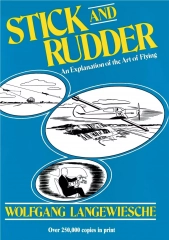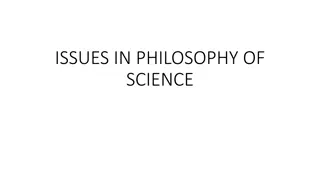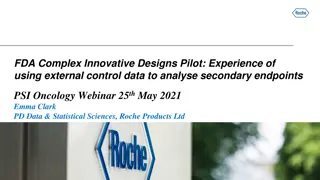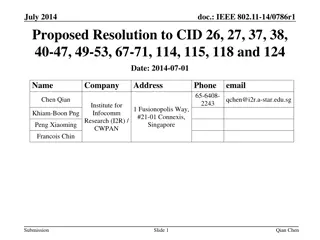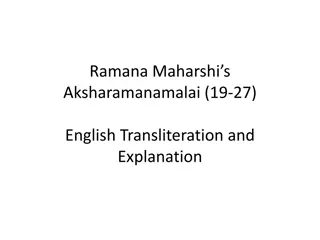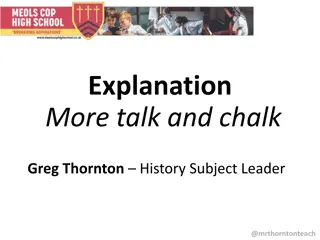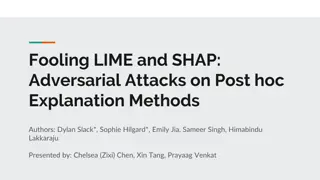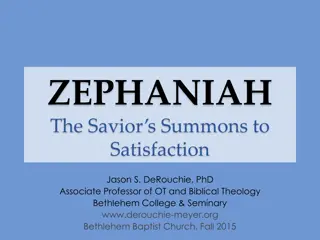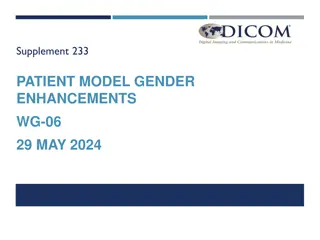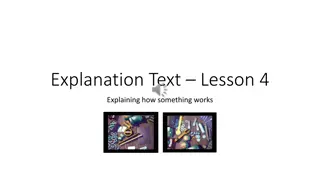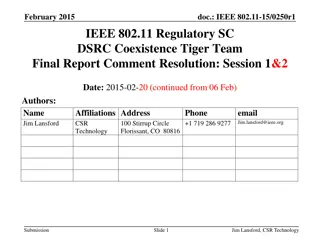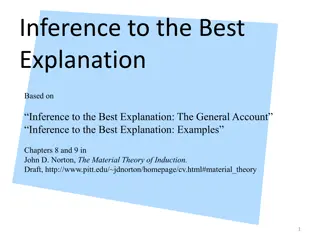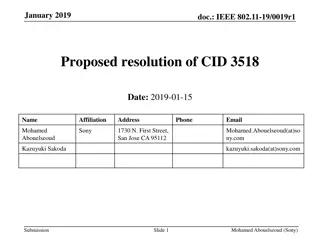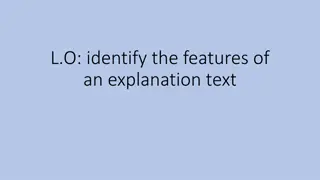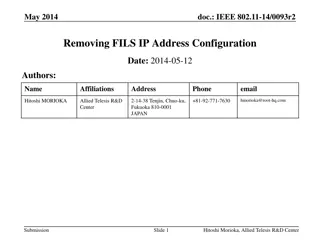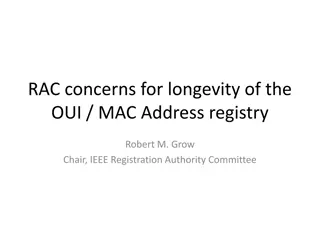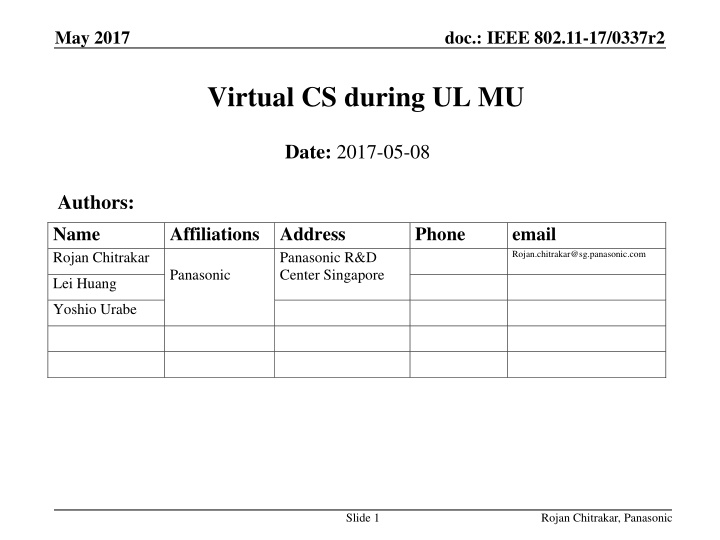
Improvements in UL MU Efficiency Triggered by IEEE 802.11-17
Discover how enhancements in virtual carrier sensing and medium access efficiency during Triggered UL MU transmissions can optimize channel utilization and prevent interference issues in wireless communications according to the IEEE 802.11-17 standard.
Download Presentation

Please find below an Image/Link to download the presentation.
The content on the website is provided AS IS for your information and personal use only. It may not be sold, licensed, or shared on other websites without obtaining consent from the author. If you encounter any issues during the download, it is possible that the publisher has removed the file from their server.
You are allowed to download the files provided on this website for personal or commercial use, subject to the condition that they are used lawfully. All files are the property of their respective owners.
The content on the website is provided AS IS for your information and personal use only. It may not be sold, licensed, or shared on other websites without obtaining consent from the author.
E N D
Presentation Transcript
May 2017 doc.: IEEE 802.11-17/0337r2 Virtual CS during UL MU Date: 2017-05-08 Authors: Name Rojan Chitrakar Affiliations Address Panasonic Phone email Rojan.chitrakar@sg.panasonic.com Panasonic R&D Center Singapore Lei Huang Yoshio Urabe Slide 1 Rojan Chitrakar, Panasonic
May 2017 doc.: IEEE 802.11-17/0337r2 Introduction In this presentation we highlight possible improvements in medium access efficiency during Triggered UL MU. The issue is mentioned in CID 8555. CID P.L Comment Proposed Change When recording the inter-BSS NAV set by an inter-BSS PPDU, in addition to recording the NAV duration of the Inter-BSS PPDU, the busy/idle state of the 20 MHz channels other than the primary 20 MHz are also recorded. A STA may also keep this record in conjunction with the HE bandwidth query report operation. This allows the virtual CS to be considered on a 20 MHz granularity as well i.e. the virtual CS is considered busy on a 20 MHz channel only if the NAV counter is nonzero and the 20 MHz channel was recorded as busy when the NAV was recorded. If the 20 MHz channels containing the allocated RUs in a Trigger frame are considered idle by both the ED based CCA as well as the virtual CS, a STA is allowed to transmit the HE trigger- based PPDU on the allocated RU. Based on the description of the subsequent paragraph, the ED based CCA considers the status of a wide band channel on a 20 MHz granularity, i.e. as long as the 20 MHz channels containing the allocated RUs are considered idle, even if the other 20 MHz channels are busy (including the primary 20 MHz), a STA is still allowed to transmit the HE trigger- based PPDU. However, the virtual CS i.e. NAV is considered over the whole wide band. Even a narrow band OBSS transmission on the primary 20 MHz channel will set the STA's Inter-BSS NAV thereby rendering all the remaining 20 MHz channels of the wide band unusable for UL MU even when the ED based CCA returns idle on those 20 MHz channels. As such, it will be beneficial to record, in addition to the duration of the Inter- BSS NAV, the busy/idle state of the 20 MHz channels other than the primary 20 MHz. If the 20 MHz channels containing the allocated RUs are considered idle by both the ED based CCA as well as the inter-BSS NAV, a STA should be allowed to transmit the HE trigger- based PPDU on the allocated RU. This will prevent a narrow band OBSS transmission from blocking the use of a wide band channel for UL MU. 8555 170.36 Slide 2 Rojan Chitrakar, Panasonic
May 2017 doc.: IEEE 802.11-17/0337r2 Background: UL MU CS Current UL MU CS rule: If the CS Required bit in a Trigger frame is set to 1, a STA solicited by the Trigger frame is required to consider the status of CCA using energy detect (ED) and the virtual CS before UL MU transmission in response to the Trigger frame. ED is performed at least on the 20 MHZ channel/s containing the RU allocated for the STA. Virtual CS indicates idle if basic NAV is zero; busy if basic NAV is non-zero. The STA is allowed to transmit HE trigger based PPDU on the allocated RU if all the following conditions are true: Virtual CS indicates idle ED returns idle on all the 20 MHz channels containing the allocated RU Slide 3 Rojan Chitrakar, Panasonic
May 2017 doc.: IEEE 802.11-17/0337r2 Motivation (1/2) During UL MU CS for triggered transmissions, STA needs to consider the result of ED sensing only on the 20 MHz channels containing the RU allocated to the STA. If a STA s basic NAV is zero and the ED sensing on all of the 20 MHz channels containing the RU allocated to the STA returns idle, the STA is allowed to transmit its trigger-based PPDU regardless of the interference on the other operating channels. ED returns busy However, if a non-AP STA s basic NAV is non-zero due to OBSS transmission on the primary channel, current UL MU CS mechanism prevents the STA s UL MU transmission even when the OBSS transmission may be a narrow band transmission and only overlaps on some of the operating 20 MHz channels of the STA. Slide 4 Rojan Chitrakar, Panasonic
May 2017 doc.: IEEE 802.11-17/0337r2 Motivation (2/2) Example: 3 3 2 2 1 1 OBSS overlaps on the primary 80 MHz 1. 2. STA2 receives a 40 MHz OBSS PPDU from AP2 and sets the basic NAV. STA2 receives trigger frame from AP1 with the CS Required bit set to 1 and performs UL MU CS. Since its basic NAV is non-zero, virtual CS indicates busy. ED sensing on CH3 and CH4 returns idle. Since virtual CS indicates busy, even though ED based sensing on CH3 and CH4 returns idle, STA2 is not allowed to transmit its trigger based PPDU on the allocated RU on CH3 and CH4. 3. Since STA2 s transmission on CH3 and CH4 would not interfere with BSS2 transmissions, not allowing the STA to transmit on the non-overlapped 20 MHz channels is a waste of valuable spectrum. Slide 5 Rojan Chitrakar, Panasonic
May 2017 doc.: IEEE 802.11-17/0337r2 Proposed enhancement to UL MU CS (1/2) When operating on wide-band channels in the 5 GHz band*, non-AP STAs keep track of bandwidth of OBSS transmissions that cause its Basic NAV to be updated: STA records the channels overlapped by OBSS transmission as OBSS BW. When the basic NAV duration counter reaches 0, OBSS BW is reset to 0. Virtual CS reports busy/idle states per 20 MHz channel. During UL MU CS, if basic NAV is non-zero virtual CS indicates the channels overlapped by OBSS BW as busy; rest of the STA s operating channels are indicated as idle. If either virtual CS or ED sensing indicates a 20 MHz channel as busy, UL MU CS returns busy, else it returns idle. Optional feature for non-AP STAs. *Note: This feature is not used in the 2.4 GHz band. Slide 6 Rojan Chitrakar, Panasonic
May 2017 doc.: IEEE 802.11-17/0337r2 Proposed enhancement to UL MU CS (2/2) Example: 1. STA2 receives OBSS PPDU from BSS2 and sets the basic NAV; at the same time it records OBSS BW as overlapping its primary 40 MHz. STA2 receives trigger frame from its AP that allocates RU to it on CH3 and CH4. Based on OBSS BW, virtual CS indicates idle for CH3 and CH4. ED sensing also returns idle for CH3 and CH4. Since both virtual CS and ED sensing indicates idle on both channels, CH3 and CH4 are considered idle and STA2 transmits the HE trigger-based PPDU. 4 4 2 2 3 3 2. 3. 4. 1 1 Parameters related to the example: CH# Basic NAV OBSS BW Virtual CS ED result UL MU CS CH4 Idle Idle Idle CH3 Idle Idle Idle > 0 40 MHz CH2 Busy Busy Busy CH1 Busy Busy Busy Slide 7 Rojan Chitrakar, Panasonic
May 2017 doc.: IEEE 802.11-17/0337r2 Updating OBSS BW For simplicity of operation, OBSS BW always records the widest OBSS channel width. 1. If an OBSS PPDU with bandwidth wider than OBSS BW is received, OBSS BW is updated to the wider bandwidth. 2. If the PPDU s channel bandwidth is narrower than OBSS BW, no changes are made to OBSS BW. 3. When the basic NAV duration counter reaches 0, OBSS BW is reset to 0. Example: S40-R OBSS1 Traffic S40-L S20 P20 S40-R S40-L STA S20 basic NAV basic NAV P20 80 0 OBSS BW: 0 40 80 80 0 1 2 S40-R OBSS2 Traffic S40-L S20 P20 This ensures that the STA s UL transmission does not interfere with OBSS transmissions. Slide 8 Rojan Chitrakar, Panasonic
May 2017 doc.: IEEE 802.11-17/0337r2 Obtaining PPDU channel bandwidth Channel bandwidth information of a PPDU can be obtained from the related parameters of the RXVECTOR issued upon the PPDU s receipt. The actual parameters used depends on the PPDU format: PPDU Format Channel bandwidth information The CH_BANDWIDTH parameter of the RXVECTOR indicates the bandwidth of the received PPDU. HE PPDU * The CH_BANDWIDTH parameter is in turn based on the Bandwidth field in the HE-SIG-A. The CH_BANDWIDTH parameter of the RXVECTOR indicates the bandwidth of the received PPDU. VHT PPDU * The CH_BANDWIDTH parameter is in turn based on the BW field in the VHT-SIG-A1 The CH_BANDWIDTH parameter of the RXVECTOR indicates the bandwidth of the received PPDU. HT PPDU * The CH_BANDWIDTH parameter is in turn based on the CBW 20/40 bit in the HT-SIG. If the NON_HT_MODULATION parameter is OFDM, the channel bandwidth is 20 MHz. If the NON_HT_MODULATION parameter is NON_HT_DUP_OFDM, the PPDU is a non-HT duplicate PPDU and CH_BANDWIDTH parameter of the RXVECTOR indicates the estimated non-HT PPDU channel bandwidth. However if the PPDU is transmitted by a bandwidth signaling STA (i.e. the TA field in the MAC header is a bandwidth signalling TA), the CH_BANDWIDTH_IN_NON_HT parameter of the RXVECTOR indicates the actual channel bandwidth of the PPDU. If the Channel bandwidth of a PPDU cannot be determined accurately, OBSS BW is set to the STA s operating channel width. Slide 9 Rojan Chitrakar, Panasonic
May 2017 doc.: IEEE 802.11-17/0337r2 Summary In this presentation we proposed improvement to the UL MU CS mechanism to improve uplink medium usage efficiency, especially in the presence of OBSSs Non-AP STAs maintain a record of the bandwidth of OBSS transmission that causes Basic NAV to be updated. Virtual CS is considered per 20 MHz channel when the basic NAV is non-zero and under certain circumstances, STA is allowed to transmit HE trigger-based PPDU even when basic NAV is set. Advantages: Improved uplink medium usage efficiency: STAs are allowed to transmit on RUs that would have been left unused with the current UL MU CS rules. No adverse effect on STAs that do not implement the feature. Optional feature for non-AP STAs. Slide 10 Rojan Chitrakar, Panasonic
May 2017 doc.: IEEE 802.11-17/0337r2 Straw Poll 1 Do you agree that the UL MU CS mechanism should be enhanced as proposed in Slide 6? Y/N/A Slide 11 Rojan Chitrakar, Panasonic
May 2017 doc.: IEEE 802.11-17/0337r2 Straw Poll 2 Do you agree to modify the 11ax specification following the comment resolutions in document 17-0336r1? Y/N/A Slide 12 Rojan Chitrakar, Panasonic
May 2017 doc.: IEEE 802.11-17/0337r2 References [1] IEEE 802.11-16/0054r1, UL MU CCA Response [2] IEEE 802.11-2016 [3] IEEE 802.11 Draft P802.11ax_D1.2 Slide 13 Rojan Chitrakar, Panasonic
May 2017 doc.: IEEE 802.11-17/0337r2 Annex Slide 14 Rojan Chitrakar, Panasonic

